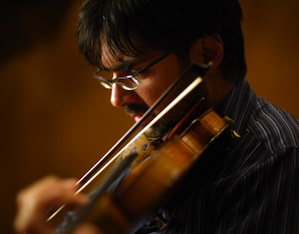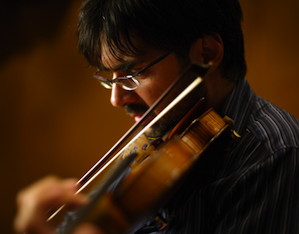
Greek violinist Leonidas Kavakos and Italian pianist Enrico Pace played an all-Beethoven program Sunday afternoon at Berkeley’s Hertz Hall presented by Cal Performances. The most striking thing about Kavakos, other than his tall stature and shoulder-length straight black hair, is his bowing technique. On the big gestures that are featured in Beethoven’s first violin sonata (Op. 12, No. 1), he would slice the bow in swift vectors, just swiping the bow across the string yet still producing a strong, resonant song. It almost seemed like period performance practice and was highly effective, especially in the early Beethoven sonatas.
In addition to these large tossed strokes, Kavakos can execute precise sautillé (rapidly firing, miniature bouncy bow articulations) with finite finger and wrist motions. The visual effect is uncanny — there hardly appears to be any movement, yet the notes speak clearly and rhythmically. Most American string players these days go by the Galamian bow hold with the stick of the bow nestled in the intermediate phalanges of the three middle fingers. Kavakos uses the old-school Auer bow grip, favored by Russians and Eastern Europeans, in which the index finger curls around the stick while the rest of the fingers clasp the stick more vertically.
The Russian bow hold looks tight but, thanks to relaxed shoulder motion, the sound Kavakos produced was a refreshing change from what, by comparison, sounds like the pressed, tense sound of many violinists. Since Kavakos’ arms are so long, he doesn’t need to straighten out his arm all the way and instead employs a lot of wrist motion to generate strokes. When the bow was at the frog (the lower, heavier part of the bow), his wrist would be bent almost 90 degrees. All of these technical details would be meaningless without the amazing music that they enable the violinist to create. Kavakos dispatched Beethoven’s motives with confidence and measured elegance. His mastery of the violin is so complete that it gives the impression that nothing stands between him and the composer.
His mastery of the violin is so complete that it gives the impression that nothing stands between him and the composer.
Pace provided sensitive accompaniment on the keyboard, but mostly on the timid side. Even in sections where the piano is clearly meant to take over, he was more than willing to stay in the background, letting even Kavakos’ accompanimental material speak in the foreground. Despite playing a little soft, his expression and phrasing were pleasurable. The duo’s rhythmic cohesion felt natural and almost effortless. It was the kind of unified music-making that gels only after many hours together in the rehearsal and recording studio. As evidence of this, Kavakos and Pace released the complete cycle of Beethoven’s violin sonatas on Decca Classics last month after performing all 10 together in Salzburg last year. The two are now touring the world with selected sonatas.
Sweet Harbinger of Spring
The “Spring” Sonata No. 5 in F Major, Op. 24, features what I consider to be Beethoven’s most beautiful melody. “Ludwig van” made his mark in history with bold ideas, gripping musical drama, and daring innovation. Melody wasn’t his finest gift, but the “Spring” Sonata is one of several gorgeous exceptions. It was phrased in this reading with beautiful simplicity and grace. Slight breaths in time where the main material is passed from the violin to piano added both nuanced individuality and surprise to the performance. The duo’s approach to Beethoven was more gentle than the brash, angry characterization that is so popular.
The “Spring” Sonata … was phrased in this reading with beautiful simplicity and grace.
The third and final piece on the program was a much stormier one, the “Kreutzer” Sonata in A Major, Op. 47. The gracious open strokes in the lighter fare that came before it was replaced by a scratchier, more biting tone. The result was like listening to a different composer and a different performer — an impressive show of versatility.
Since the program was rather short, an encore was inevitable, but the choice of repertoire is always interesting. Would the duo stick to the strictly Beethoven theme? Or insert some variety? They chose to go with something utterly contrasting: the Russian Dance from Igor Stravinsky and Samuel Dushkin’s arrangements of the Petrushka ballet, paired with the slow-movement dithyrambe of the Duo Concertante, also by Stravinsky. The Russian Dance was a riot, with painfully loud pizzicatos and an even more intense sound quality that wasn’t used earlier in the program. The brief hymn at the very end stunned the audience into a perplexed silence.

